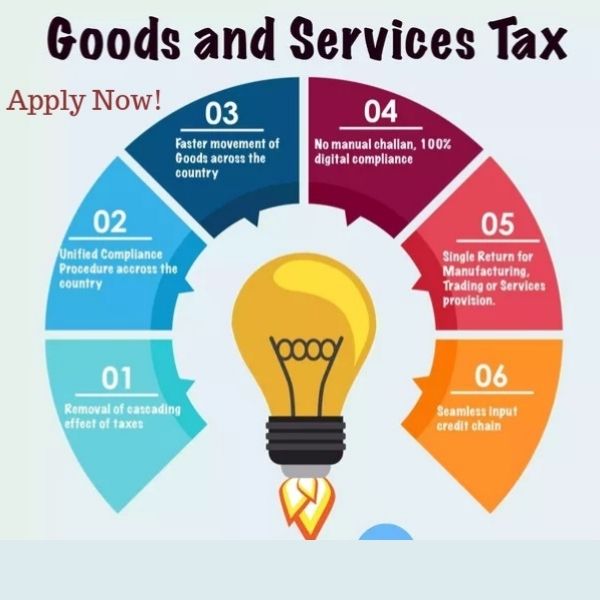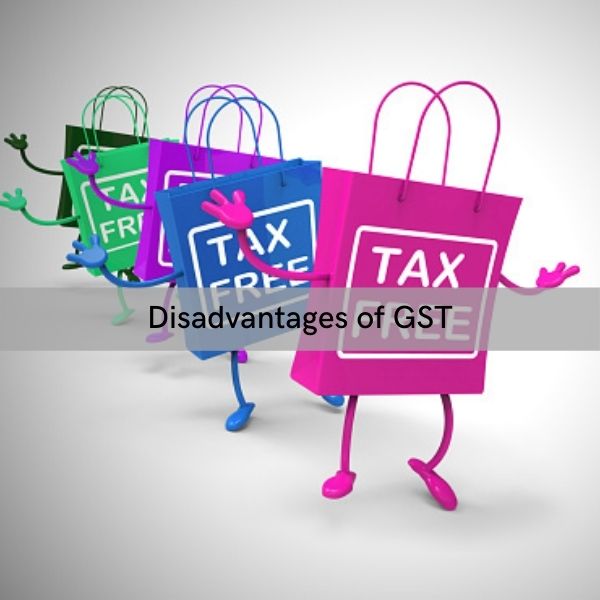The meaning of GST is goods and service tax. That means the tax over good and the services done by dealers. It is one type of indirect tax levied on goods and services. It will not have any impact on direct tax. Taxes such as VAT, excise duty, etc was replaced by GST. There are two types of GST that are CGST and SGST, which will be discussed in this article. Let us understand the basics information of GST with one example. If you buy Rs 100 /- product and sell in Rs 110 /-. Then the GST will only apply on Rs 10 /- profit. In that case. you have to pay the tax only on the gained profit. The rest is the tax liability of the end customer. In this article, we will study, detailed information about GST such as what is GST, disadvantages of GST, etc.
What is the Meaning of GST?
It is one type of indirect tax. Let’s understand with one example. Suppose, the seller sells an item to the consumer, and consumers do the payment. That means the consumer give GST to the seller. And the seller will forward this tax to the government by filling the return. Generally, GST is known as ‘one nation one tax’. But what is the meaning of this catchphrase? So let’s understand by taking the example of Singapore. If we talk about Singapore, in Singapore all products are taxable at a 7% rate. That means if consumers purchase any product, they have to pay a 7% tax. So if we talk about India there are many diversities. The rich are the richest and the poor are the poorest. So we can not sell products to both categories at the same rate. So in India, it is said that ‘ one product one tax ‘.

What was the Objective?
The main objective of the Modi government to bring this tax system was to streamline the complex indirect tax system in India. Before GST, our Indirect tax system was as convocated as some math problem. Because there were several taxes, separate for center and state. For example center excise duty, additional duty, CVD, SAD, service tax surcharges, and cess level by the center. And the taxes such as VAT, purchase tax, central sales tax, etc for states. So, all these taxes were eliminated and consolidate into GST on 1 July 2017. Therefore, with GST government centralized the existing federal structure of our tax system. That means a consumer in Kanyakumari will be paying the exact same tax as that in Kashmir which will be determined by the central council.
Information About Types of GST
CGST Meaning in GST (Center Goods and Service Tax)
The meaning of CGST in GST is center goods and service tax. Hence, CGST is the centralized part of GST, that subsumes the present central taxation and levies. If you sell or buy products from one state, then you have to pay CGST. It is 9% of your total amount. And hence, this tax will go to the central government.
SGST Meaning in GST (State Goods and Service Tax)
The meaning of SGST in GST is state goods and service tax. Hence, it is the state part of GST, that subsumes the present state taxable and levies. If you sell or buy products from one state, then you have to pay CGST. It is 9% of your total amount. And hence, this tax will go to the state government.
IGST Meaning in GST (Integrated Goods and Service Tax)
The meaning of IGST in GST is Integrated goods and services tax. Therefore, the IGST is levied on the interstate transactions of goods and services. That is by supplying goods from one state to another state.
UGST Meaning in GST (Union Territory Goods and Service Tax)
The meaning of UGST in GST is union territory goods and service tax. This type of tax system is similar to CGST and SGST but only has one difference. That is, this tax is the union territorial part of GST. The rate to pay in UGST is similar to SGST.

Information About Types of Schemes in GST
Normal Scheme
- There is no limit on turnover.
- Under the normal scheme, the dealer can do both interstate and intrastate supply.
- In a normal scheme, you can get an input tax credit.
- Both people of supplying goods and services can opt for a normal scheme.
- In a normal scheme, tax rates are under the normal tax rates slab.
- Dealers can do both taxable as well as non-taxable supplies.
- In a normal scheme, you can do goods supplies and service supplies through e-commerce.
- Manufacturing of all items is allowed in the normal scheme.
- Under the normal scheme, returns have to file monthly.
- There is a facility of the Input tax credit on reverse charge in the normal scheme.
Composite Scheme
- You can opt for a composite scheme, only if your turnover is less than Rs 75 Lakh.
- Under the composite scheme, the dealer can not do interstate supply.
- In a composite scheme, you can not get an input tax credit.
- A person supplying goods can opt for a composite scheme. Under service tax, only a restaurant service providing the person is allowed.
- In the composite scheme, tax rates are fixed. For dealers it is 1%, for manufacturers is 2%, and for the restaurant is 5%.
- In composite dealers can only do taxable supplies.
- You can not do goods supplies and service supplies through eCommerce.
- If the government gives information or notify some object under the GST recommendation then such an object can not be manufactured.
- Under the composite scheme, returns have to file quarterly.
- Input tax credit on the reverse charge is not allowed in the composite scheme.
Benefits of GST
- As the aspirant, there were no long queues of trucks at the state borders anymore.
- The transportation of goods across the country has become much easier due to this tax system.
- There is a unified and identical tax system across the nation.
- The digitization of the tax system was also initiated in tandem with this tax system.
- The rise of inflation was also forecasted as the result of this tax system, but it is also controlled by the government.
- Legally you can collect tax from your customer and pass on to your suppliers.
- If your GST filing and IT returns are proper, then you can easily get a guarantee free loan. To know about government loan schemes in detail click here.
- You can grow your business in many ways, such as online, import and export, etc.
- You can easily apply for state and government tenders.

Disadvantages of GST
Failed Implementation
- Where the meaning and principal agenda of GST was to simplify and unify the tax system. It had made the tax system more complicated. This was the major disadvantage of GST.
- It could have been studied and outlined better.
- Forgot population, even the government was not sure about what rates are to be levied, how much to be levied, and so on.
- Council offers the entire range of tax slabs.
- From 0% to 28%, there were many options in this tax system.
- The things which can generate more revenue for states, like liquor and tobacco, not included in this tax system.
- Later, when the states weren’t able to fulfill their tax targets, compensation cess, and other duties on the product shot up. This causes the states many disadvantages due to GST.
- Due to the implementation of this tax system, lier services costs have also increased. Such as the cost of courier services, rail and air tickets, school fees, house rents, etc.
- This made fake invoices in cottage industries increase by all means.
- The implementation of this tax in India will also show an impact on the real estate market. It will increase the cost of new homes by 8%, which in turn sized the demand by12%.
- These were the major disadvantages that cause the failed implementation of GST.
What Went Wrong?
- Firstly, the decision of bringing GST was made in the nast. Then GST causes major disadvantages and becomes failed and above all the overconfidence.
- The central government declares that in case the states are not able to achieve a 14% growth in their revenue collection, the central government will bear the difference for the state.
- Then what neither did the states fulfill their targets nor did the government had the capital to compensate.
- This tax does not just fell short of its target but the revenue collection even decreased below the previous year collection.
- Moreover, there was no decrease in MRP, despite decreasing the tax burden.
- Due to the consumer like us didn’t get any benefits at all.
- Consequentially, consumption shrunk that made the GDP decline and the economy fall.
- The above all reasons went wrong while making the decision of the GST and this cause a major disadvantage to the country.

Who needs GST Registration?
- Business having an annual turnover of more than Rs 20 lakh per annum. (Rs 10 lakh for northeastern state)
- Businesses dealing in more than one state.
- If your business has previous registration under VAT, Excise, Laws, Service tax laws.
- If you are selling your goods or service online. Like on Amazon and Flipkart.
- Have an import and export business.
Penalty Under No GST Registration
- If you have not done GST registration or GST invoice, then you will charge a 100% tax due or Rs 10,000 /-.
- By giving an incorrect invoice, you can get a penalty up to Rs 25,000 /-.
- If you fail to file a GST return. Then you can get a penalty of up to Rs 20/day for nil return and Rs 50/day for regular return.
- Choosing a composite scheme even if not eligible can give a penalty of Rs 10,000/- or 100% tax due.
Registration Process for GST
- Go to the official website of GST.
- Then click on the service and then click on new registration.
- Fill the details in the registration form. And click on to proceed.
- On the next page, you will get your temporary registration number.
- Then you need to fill the 9 forms related to your business and click on to proceed.
- Then you will get your acknowledgment number once your application will get submitted successfully.
- Once your application is approved you will get your GST certificate.
FAQ Regarding Meaning and Information of GST
The documents required are
Aadhar Card
PAN Card
Company PAN Card
Company Address Proof
Cancel Cheque of Business Account
Passport Size Photo
No, it is not required to issue the invoice and the bill of supply separately. You can give the same invoice for the taxable and the exempt product supply.
Generally not. But required in case of inter state supplies having invoice value more than Rs 2.50 lakh.
No, it is not necessary to do separate registration for trading and manufacturing by one person in one state.
Tax is payable on consideration received, for the supply.
Yes, GST will be paid by you to the government if you purchase goods from unregistering person.
Editor’s Note | Meaning of GST
As the COVID-19 pandemic affected every sector in the word. So, let’s talk about the effect of COVID-19 on GST in India. Due to COVID-19 the date of the GST audit annual return has extended. CBI has announced in its latest tweet. That the government has extended the due date for furnishing annual return in GST-9 and GST-9C for 2018-2019 from 30/09/2020 to 31/10/2020. My suggestion is that don’t expect the date extension and fill your GST on time.

